calsfoundation@cals.org
Shriners
aka: Ancient Arabic Order of the Nobles of the Mystic Shrine
Shriners International, formally known as the Ancient Arabic Order of the Nobles of the Mystic Shrine, is a fraternal organization commonly known as the Shriners. The order inducted its first two Master Masons on August 13, 1870, and the remaining eleven charter members on June 16, 1871. Arkansas has two chapters: Sahara Shrine in Pine Bluff (Jefferson County), founded in 1889 and chartered the next year; and Scimitar Shrine in North Little Rock (Pulaski County), founded in Little Rock (Pulaski County) as Al Amin Temple in 1904 and chartered early the next year.
Historically, to become a noble of the Shrine, a potential member had to complete three degrees and a series of tests to become a Master Mason of the Masonic fraternity. The aspiring noble then proceeded through the rituals of the Scottish or York rites (both Masonic orders) and received the Order of the Temple in the York Rite or attained the thirty-second degree of the Scottish Rite. In 2012, there was a schism between Shriners International and the Grand Lodge of Free and Accepted Masons of Arkansas. Freemasons who did not resign their membership in the Shrine were thereafter expelled from the Masonic fraternity in Arkansas. Consequently, Arkansas is the only place in the world where Shriners are no longer required to be Masons to join Sahara or Scimitar temples. A man seeking admission submits an application to a membership committee and undergoes a background check. Members of the respective temple then vote on whether or not to accept the application.
Like most other Masonic organizations, Shriners International embraces a Middle Eastern theme in its regalia and rituals, paying homage to the culture, history, and traditions of the Levant. Accordingly, Shriners wear a red fez with a tassel, emblazoned with the name of their home temple and often their respective role. The motto of the order is “Strength and Fury,” and the jewel of the order is a crescent pointing downward. Shriners are known for their elaborate costumes, their participation in parades, and their support for Shriners Hospitals for Children. Shrine clowns are renowned performers.
Sahara Shrine
Sahara Shrine of Pine Bluff was organized on April 16, 1889, existing under dispensation until the June 23, 1890, meeting of the Imperial Council granted a charter that made Sahara the mother temple of Arkansas and the forty-ninth temple of the fraternity. Sahara’s jurisdiction included the entire state until 1904, when jurisdiction was divided with Al Amin Temple in Little Rock. In 2018, Sahara held concurrent jurisdiction in twenty-five counties in the state and exclusive jurisdiction in twenty-three counties.
Sahara held its meetings in the Masonic lodge at 2nd and Chester from 1889 to 1913 before moving to 7th and Main. Outgrowing that temple, Sahara moved into a new building at Martin and Pine, dedicating it on April 26, 1928. The Great Depression forced Sahara to find less expensive quarters, moving to 308 West 2nd Ave. on December 15, 1938. Sahara began residing at its current temple, a former supermarket, at 9th and Main on October 11, 1972. This new site gave Sahara 16,000 square feet of floor space and parking for 200 automobiles. A 12,980-square-foot adjacent facility was built in September 1983 to provide room for units, storage, activities, and events.
The Imperial Council recognized Sahara Shriners for their work for the Shiners Hospitals for Children. Sahara won the Sphinx Award for three consecutive years and earned the right to keep the trophy permanently. The trophy was put on display at the National Archives of the Masonic Temples in Washington DC.
Scimitar Shrine
What later became Scimitar Shriners of North Little Rock was founded as Al Amin Temple in Little Rock on December 19, 1904, when sixty-six Sahara Shriners and five additional Nobles were granted consent to establish a sister temple in the capital city. In 1911, Al Amin bought the land at 21st and Main from the Knights of Pythias. Temple members bought bonds to finance construction costs. The cornerstone was laid on September 28, 1912.
In 1925, Scimitar Shriners purchased about 400 acres of land located south of Little Rock, near East End, fencing 300 acres and Pine Lake. With rock taken from Pinnacle Mountain and hauled by wagons and trucks to the property, they built a new country club featuring an eighteen-hole golf course. Businessmen bought bonds to supply funds for the Shrine Country Club, which served as one of Little Rock’s favorite entertainment destinations through 1937.
Following the 1929 stock market crash, the payment and principal interest due on the construction bonds became difficult to pay. In 1937, Scimitar Shriners relinquished both the country club and the property at 21st and Main under foreclosure proceedings. Meetings were moved to West 3rd Street, and Al Amin surrendered its charter on June 24, 1937. Scimitar Shriners received its dispensation immediately and was chartered on June 8, 1938, as the 159th temple to take out a charter.
On September 10, 1939, the Pulaski County Chancery Court’s special chancellor Jerome H. Bowen ordered the temple sold. The Knights of Pythias bought the land, building, and personal property, but the property reverted back to the Shrine due to negotiations between the Knights and Shriners. The Shrine re-purchased the property, including the temple and an old adjacent building to the south. Meetings continued at 21st and Main until an arsonist destroyed the building in 1985.
In 1983, Scimitar Shriners purchased and cleared six acres in south Little Rock near Interstate 30. Construction started in 1984 on the $1.2 million temple at the newly named Scimitar Circle, with the cornerstone laid in July 1986. An additional two acres purchased in 1988 included a parking lot, a storage building, restroom facilities, a pavilion, tables, and landscaping. While originally chartered for Little Rock, Scimitar sold its facility in 2017 and moved to 631 West Riverfront Road in North Little Rock, near Dickey-Stephens Park in the Argenta commercial district.
Membership and Activities
In 2018, Sahara Shriners listed 309 members and Scimitar Shriners listed 300 members. Arkansas Shriners host the annual Shrine Circus; march with band, drum, and bugle corps; and drive their custom cars and motorcycles in parades. They operate haunted houses, sell Vidalia onions, and entertain children at public events with their clowns. Other activities include banquets, public dances, rodeos, and golf tournaments.
Shrine temples are divided into clubs and units. Clubs serve Shriners in a particular geographic region that is far away from the temple. In 2018, Sahara Shrine operated five clubs: Delta Shrine Club (West Memphis), Hot Springs Village Shrine Club, Texarkana Shrine Club, Twin Lakes Shrine Club (Bull Shoals), and SEARK Shrine Club, which serves southeastern Arkansas. Scimitar Shrine Clubs include the Nomad Shrine Club of northwestern Arkansas, the North Pulaski Shrine Club, and the Spring River Shrine Club (Cherokee Village). Scimitar Shrine Club also hosts a women’s auxiliary known as the Daughters of the Nile, an independent 501 (c)(3) charity that has its own branch unit that meets at Sahara in Pine Bluff. Units perform activities in support of the temple or are devoted to a special purpose. Sahara has a number of units, including the Bedouins (a firetruck parade unit), Explorers (a unit that drives large motorized tricycles in parades), Klassy Klowns (their clown unit), Sportsmen’s Club (for membership recruitment), Motor Patrol (a unit that rides vintage Cushman Eagle Motorcycles in parades and competitions), and Wild Hogs (a modern motorcycle riding club). Scimitar operates the parade unit Bedouins, as well as the Funraisers Unit (for temple advancement), the Scimitar Clown Unit, the Director’s Staff (largely responsible for membership initiation and ritual), and the Misfits, who also operate motorized trikes for parades and competition.
Most importantly, both Arkansas Shrine temples are formally dedicated to supporting Shriners Hospitals for Children. With the first built in Shreveport, Louisiana, in 1922 to combat the polio epidemic, by 2018, Shriners Hospitals for Children included twenty-two facilities across North America, devoted to providing juvenile orthopedic and burn care, as well as the treatment of spinal and cleft palate deformities, providing care to children from birth to eighteen years old at no cost to the family. Since 1922, Sahara and Scimitar Shriners have sponsored thousands of children to receive care at Shriners Hospitals, popularly known as Temples of Mercy.
For additional information:
International Shrine Clown Association. www.shrineclowns.org (accessed January 26, 2022).
Sahara Shrine. https://www.saharashriners.com/ (accessed January 26, 2022).
Sahara Temple A.A.O.N.M.S., 1987. Pine Bluff, AR: Sahara Temple, 1987.
Scimitar Shrine. http://www.arkansasshriners.com/ (accessed January 26, 2022).
Scimitar Temple A.A.O.N.M.S., Vol. 3, 1997. Little Rock: Scimitar Temple, 1997.
Ronald Sitton
North Little Rock, Arkansas
Kyle Day
University of Arkansas at Monticello
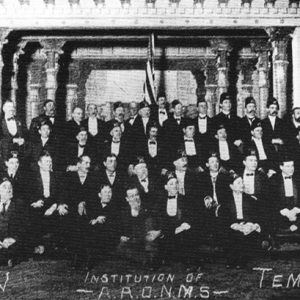 Al Amin Shriners
Al Amin Shriners 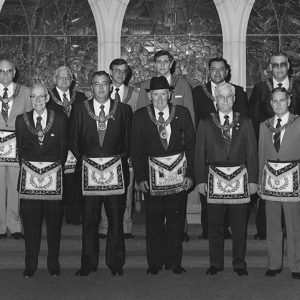 Grand Lodge Officers
Grand Lodge Officers  Klassy Klowns
Klassy Klowns  Sahara Temple
Sahara Temple 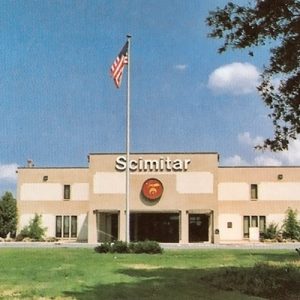 Scimitar Temple
Scimitar Temple 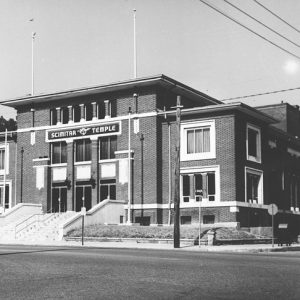 Scimitar Temple
Scimitar Temple 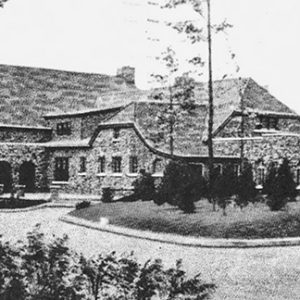 Shrine Country Club
Shrine Country Club 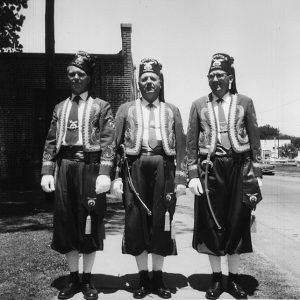 Sahara Temple Shriners
Sahara Temple Shriners 




The old Little Rock Shrine Club on Arch Street Pike holds many pleasant memories for me. As a child of seven, I spent many Sunday afternoons roaming through the huge building, hiking the grounds, and swimming in the lake while Mom and Dad played golf. I was in the care of my older brother, Edward, at the time. The club manager was Ben Shelly. I remember well being present at the Potentates Ball held in honor of my dad. The ballroom had large shield decorating at least one wall. On the wall of the adjacent dinning room was a mounted marlin reportedly caught by Mr. Shelly. The building and lake are most vivid in my memory. The building was built in 1926 for a cost of approximately $100,000. The sandstone for the building was taken from Pinnacle Mountain west of Little Rock. Sadly, as a result of the Crash of 29, the Shrine Club was forced into bankruptcy, and they were forced to sell the property and reorganize. To this day, I go out of my way to catch a glimpse of that beautiful building, lake, and landscape. Precious memories.